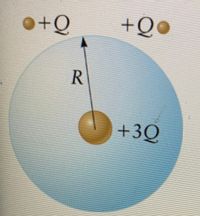
College Physics
11th Edition
ISBN: 9781305952300
Author: Raymond A. Serway, Chris Vuille
Publisher: Cengage Learning
expand_more
expand_more
format_list_bulleted
Concept explainers
Question
Three point charges are located near a spherical Gaussian surface of radius 14.5 cm. One charge (+3Q =12.9 μC) is inside the sphere, and the others (charge +Q =4.3 μC) are a distance 4.83333333333333 cm outside the surface.
What is the total (net) electric flux through the Gaussian surface?

Transcribed Image Text:O+Q
+Q•
+30
Expert Solution
This question has been solved!
Explore an expertly crafted, step-by-step solution for a thorough understanding of key concepts.
This is a popular solution
Trending nowThis is a popular solution!
Step by stepSolved in 2 steps

Knowledge Booster
Learn more about
Need a deep-dive on the concept behind this application? Look no further. Learn more about this topic, physics and related others by exploring similar questions and additional content below.Similar questions
- A point charge of -3.80 µC is located in the center of a spherical cavity of radius 6.50 cm inside an insulating charged solid. The charge density in the solid is +8.70 x 10-4 C/m³. Calculate the magnitude of electric field inside the solid at a distance of 9.50 cm from the center of the cavity. Answer: ✓ Choose... MN/C (mega N/C) kN/C N/Carrow_forwardInside a spherical surface is a 5.3 x 10-6C and a -2.2 x10-6 C charge. What is the total electric flux through the surface of the sphere in units of N m2/C? Select one: O a. 3.5 x 105 O b. 2.8 x 104 О с. 3.1 3 х106 O d. the area must be known. О е. 3.43 х 10-16arrow_forwardAn unknown charge sits on a conducting solid sphere of radius 13 cm. If the electric field 21 cm from the center of the sphere has magnitude 3.5 × 103 N/C and is directed radially inward, what is the net charge on the sphere?arrow_forward
- A solid sphere of radius 40.0 cm has a total positive charge of 25.0 µC uniformly distributed throughout its volume. Calculate the magnitude of the electric field at the following distances. (a) 0 cm from the center of the sphere kN/C(b) 10.0 cm from the center of the sphere kN/C(c) 40.0 cm from the center of the sphere kN/Carrow_forwardA charge of 22.2 pC is distributed uniformly on a spherical surface (r = 2.0 cm), and a second charge of – 14.1 pC is distributed uniformly on a concentric thin spherical surface (r2 = %3D 4.0 cm). Determine the magnitude of the electric field ( in units of N/C) at a distance of 5.0 cm from the center of the two surfaces.arrow_forwardIn the figure a solid sphere of radius a = 3.00 cm is concentric with a spherical conducting shell of inner radius b = 2.00a and outer radius c = 2.40a. The sphere has a net uniform charge q1 = +5.10 fC; the shell has a net charge q2 = –q1. What is the magnitude of the electric field at radial distances (b) r = a/2.00, (c) r = a, (d) r = 1.50a? What is the net charge on the (g) inner surface of the shell?arrow_forward
- A square that has 10 cm long edges is centered on the x axis in a region where there exists a uniform electric field given by E = (2.00 kN/c)î. (a) What is the electric flux of this electric field through the surface of a square if the normal to the surface is in the +x direction? N. m2/c (b) What is the electric flux through the same square surface if the normal to the surface makes a 70° angle with the y axis and an angle of 90° with the z axis? N. m2/carrow_forwardAn unknown charge sits on a conducting solid sphere of radius 9.5 cm. If the electric field 13 cm from the center of the sphere has magnitude 4.3 × 103 N/C and is directed radially inward, what is the net charge on the sphere?arrow_forwardA cylinder has a volume of 5.2 cm^3 and a charge density of 6.1 μC/cm^3, and is enclosed in a spherical surface with a radius of 17.5 cm. What is the total charge on the cylinder? What is the total electric flux through the surface of the sphere?arrow_forward
arrow_back_ios
arrow_forward_ios
Recommended textbooks for you
 College PhysicsPhysicsISBN:9781305952300Author:Raymond A. Serway, Chris VuillePublisher:Cengage Learning
College PhysicsPhysicsISBN:9781305952300Author:Raymond A. Serway, Chris VuillePublisher:Cengage Learning University Physics (14th Edition)PhysicsISBN:9780133969290Author:Hugh D. Young, Roger A. FreedmanPublisher:PEARSON
University Physics (14th Edition)PhysicsISBN:9780133969290Author:Hugh D. Young, Roger A. FreedmanPublisher:PEARSON Introduction To Quantum MechanicsPhysicsISBN:9781107189638Author:Griffiths, David J., Schroeter, Darrell F.Publisher:Cambridge University Press
Introduction To Quantum MechanicsPhysicsISBN:9781107189638Author:Griffiths, David J., Schroeter, Darrell F.Publisher:Cambridge University Press Physics for Scientists and EngineersPhysicsISBN:9781337553278Author:Raymond A. Serway, John W. JewettPublisher:Cengage Learning
Physics for Scientists and EngineersPhysicsISBN:9781337553278Author:Raymond A. Serway, John W. JewettPublisher:Cengage Learning Lecture- Tutorials for Introductory AstronomyPhysicsISBN:9780321820464Author:Edward E. Prather, Tim P. Slater, Jeff P. Adams, Gina BrissendenPublisher:Addison-Wesley
Lecture- Tutorials for Introductory AstronomyPhysicsISBN:9780321820464Author:Edward E. Prather, Tim P. Slater, Jeff P. Adams, Gina BrissendenPublisher:Addison-Wesley College Physics: A Strategic Approach (4th Editio...PhysicsISBN:9780134609034Author:Randall D. Knight (Professor Emeritus), Brian Jones, Stuart FieldPublisher:PEARSON
College Physics: A Strategic Approach (4th Editio...PhysicsISBN:9780134609034Author:Randall D. Knight (Professor Emeritus), Brian Jones, Stuart FieldPublisher:PEARSON

College Physics
Physics
ISBN:9781305952300
Author:Raymond A. Serway, Chris Vuille
Publisher:Cengage Learning

University Physics (14th Edition)
Physics
ISBN:9780133969290
Author:Hugh D. Young, Roger A. Freedman
Publisher:PEARSON

Introduction To Quantum Mechanics
Physics
ISBN:9781107189638
Author:Griffiths, David J., Schroeter, Darrell F.
Publisher:Cambridge University Press

Physics for Scientists and Engineers
Physics
ISBN:9781337553278
Author:Raymond A. Serway, John W. Jewett
Publisher:Cengage Learning

Lecture- Tutorials for Introductory Astronomy
Physics
ISBN:9780321820464
Author:Edward E. Prather, Tim P. Slater, Jeff P. Adams, Gina Brissenden
Publisher:Addison-Wesley

College Physics: A Strategic Approach (4th Editio...
Physics
ISBN:9780134609034
Author:Randall D. Knight (Professor Emeritus), Brian Jones, Stuart Field
Publisher:PEARSON